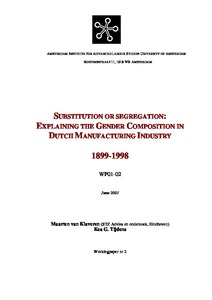Substitution or segregation: explaining the gender composition in Dutch manufacturing industry 1899-1998
"This paper focuses on the role of substitution or segregation in the demand for female labour. Based on an extensive overview of detailed studies, fluctuations in the gender composition of the labour force in four major sectors of Dutch manufacturing industry have been examined over the past h...
| Main Authors: | , |
|---|---|
| Institution: | ETUI-European Trade Union Institute |
| Format: | TEXT |
| Language: | English |
| Published: |
Amsterdam
2001
AIAS |
| Subjects: | |
| Online Access: | https://www.labourline.org/KENTIKA-19299933124910171159-Substitution-or-segregation-ex.htm |
| Summary: | "This paper focuses on the role of substitution or segregation in the demand for female labour. Based on an extensive overview of detailed studies, fluctuations in the gender composition of the labour force in four major sectors of Dutch manufacturing industry have been examined over the past hundred years. Women’s share in employment has been stable in clothing industry, fluctuated in textiles, increased in food production and decreased in Philips Electronics. Changes in the share of women were primarily explained by segregation that is by fluctuations in employment in the male respectively female domains. Only few examples of substitution were traced, primarily driven by labour market shortages, but the numbers of workers involved were small. Overwhelmingly, employers preferred to act within gender boundaries." |
|---|---|
| Physical Description: | 28 p. Digital |

